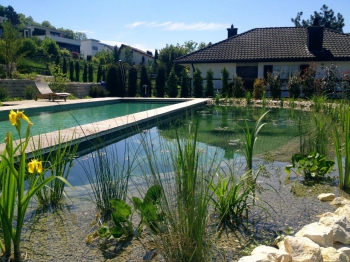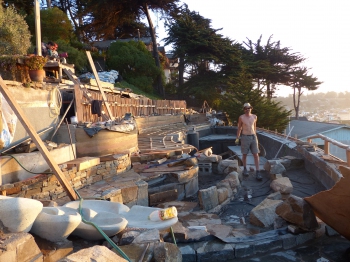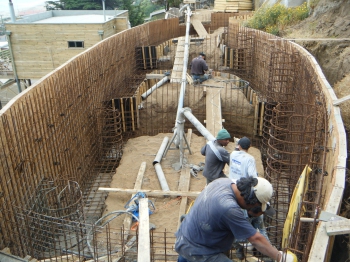 EcoPools are generally built in two parts: swimming zone and ecosystem zone. Both parts are contained in a waterproof membrane called the “shell”. Shells can be built from a variety of materials and the choice of material depends on considerations such as budget, material aesthetics, availability of skilled labour, soil conditions, ground water and to a large degree, environmental responsibility.
EcoPools are generally built in two parts: swimming zone and ecosystem zone. Both parts are contained in a waterproof membrane called the “shell”. Shells can be built from a variety of materials and the choice of material depends on considerations such as budget, material aesthetics, availability of skilled labour, soil conditions, ground water and to a large degree, environmental responsibility.
There are many, many different and interesting ways to effectively waterproof an area to contain water. Some less economical than others and some, that although 100% environmentally friendly, require a reasonably high level of maintenance. For reasons of longevity, product guarantee and quality of our workmanship we have outlined our preferred shell installation systems below. As in-field professionals we are always pleased to research, advise, assist or install any water containment system that a client may be interested in selecting.
 Liners
Liners
Environmentally, liners are currently thought to be the most conscientious way to build and are best suited to large, open space water features that incorporate a swimming zone surrounded by an ecological zone.
In Europe, liner styled materials are widely available to high standards of quality and workmanship, allowing us to select the most efficient and environmentally conscientious liners currently on the market for use in any European project country. In Africa we use two different types of liners: PVC - which can either be virgin material or recycled from old advertising banners - or rubber. Our African rubber liners are very durable, guaranteed for 25-30 years and will last for hundreds. In Brazil and the South Americas, we elect to use EPDM liners from reliable and sustainably managed sources. Again, when installed correctly with a certified membrane welder, they are guaranteed for approximately 25 years, but will last a very long time if maintained correctly.
Biological Liners
Currently in Africa we are developing a cellulose matrix liner which acts as a structural framework for bacterial and fungal organisms to attach to. These liners create a very specific style of ‘living’ waterproof shell. The idea was gleaned from rural African aquaculture projects where cabbage or banana leaves are used traditionally to line ponds. It is a wonderful liner system and we are looking forward to presenting it to a wider Global market.
Fiberglass  Premoulded fiberglass shells are often the fastest to install. When purchased from a reputable supply and installed with the correct management, they will serve for approximately 15 to 25 years with very little maintenance. Fibreglass is an highly understated product mostly due to poor client experiences with insufficiently skilled installation teams and or lack of customer service from supply companies which is very unfortunate.
Premoulded fiberglass shells are often the fastest to install. When purchased from a reputable supply and installed with the correct management, they will serve for approximately 15 to 25 years with very little maintenance. Fibreglass is an highly understated product mostly due to poor client experiences with insufficiently skilled installation teams and or lack of customer service from supply companies which is very unfortunate.
As a material, it functions very well if treated correctly and retained below the water level of the swimming pool or sufficiently protected from the elements, above the water line. The raw materials for a fiberglass construction method are easily transported and for use within bespoke designs, have evolved alongside concrete with systems for projected installation. Modern technology has made fiberglass a recyclable material that creates a high quality, flexible and resistant finish with a very low environmental impact.
Concrete and Concrete blockwork
The disadvantage of concrete and cementitious products is that they  require a high level of skilled workmanship to achieve a well built, water resistant membrane with the minimum possible amount of material wastage/ spillage to keep them to a high level of quality of construction, relevant to their environmental footprint.
require a high level of skilled workmanship to achieve a well built, water resistant membrane with the minimum possible amount of material wastage/ spillage to keep them to a high level of quality of construction, relevant to their environmental footprint.
The best value for money comes as a compromise with environmental responsibility. When built ‘well’ steel reinforced concrete/ concrete blockwork is still the most practical, economical and available shell construction system for most swimming pools in urban/ suburban areas. The advantage is that it can be used to form any design shape. It is strong, installed with manageable parts in tight spaces and particularly resistant in areas where there is persistent groundwater. Concrete pool shells are very hardy, regularly guaranteed for 25+ years and will last a very, very long time if maintained correctly.

Bespoke construction systems
The systems mentioned here are given as an outline for their uses in the construction of swimming pools as a whole. It is often the case that ‘one’ of the above systems will not achieve a client’s needs as a system in its own right, and will often need the incorporation of another to fulfill the project requirements. Our installation teams are specialized in their separate construction fields, and when required, collaborate with secondary materials specialists to conclude their part of a project, prepared and ready to accept any specification for the following workmanship.





